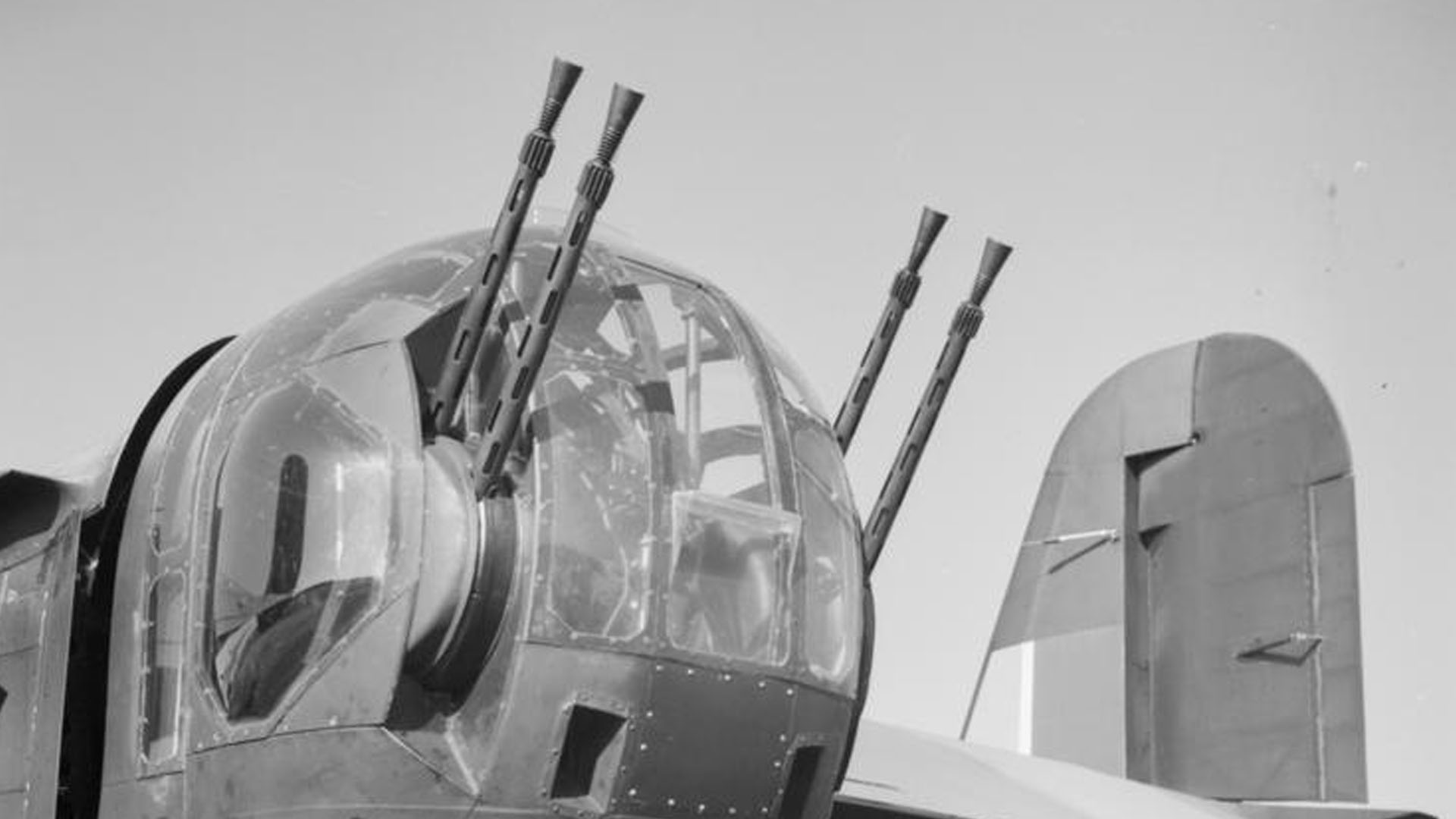Pilot Officer James Stirling Moore (156433) served in the Royal Air Force during the Second World War. He was the son of Thomas Moore and Miriam R. Moore of Belfast. Family and friends knew him as Stirling.
As a young man, Stirling was a talented amateur footballer. His name features in the publication ’75 Years of the Northern Amateur Football League’. His blossoming football career ended during the 1938-1939 season through both injury and the outbreak of the Second World War.
R.A.F. 78 Squadron
Serving in R.A.F. 78 Squadron, Pilot Officer Moore was the Navigator in Peter “Bunny” Bunclark’s crew. Captain Bunclark was the most experienced in the Squadron, and nearing the end of his second tour. He had won a Distinguished Flying Medal on his first and was on his way to a Distinguished Flying Cross.

Imperial War Museum Photo: CH 11320 (Part of the Air Ministry Second World War Official Collection). Boulton Paul Type 'E' tail gun-turret, mounting four .303 machine guns, on a Handley Page Halifax Mark II of No. 78 Squadron R.A.F. at Breighton, Yorkshire. Photo taken by Flight Lieutenant G Woodbine.
A Lucky Escape
On 3rd July 1943, Bunclark crash-landed Halifax JD203 near 30 Acres Barn, Ashtead, Surrey, England. The plane had lost two engines on the same wing making it impossible to control. The Halifaxes took off just after 2300hrs from RAF Breighton in East Yorkshire bound for a night raid on Cologne. Their outward route took measures to avoid anti-aircraft fire as they joined hundreds of other planes on the mission. The mission was successful. Bunclark’s crew dropped bombs and reported a concentration of fires in Cologne. Their luck changed on the return journey.
Flak hit the plane as the enemy opened fire on the Halifax. The gunfire took out the first engine and caused damage to the second. While on the journey back to England, this engine also stopped working. The plane steered to one side making it difficult for the crew to navigate to an airfield on the south coast. The crew jettisoned all unnecessary equipment over the sea to lighten the load.
With the lights of London fast approaching, James Stirling Moore baled out. All other crew members apart from the pilot and first engineer joined him in his escape. Bunclark and Matthews forced a crash landing and walked away uninjured.
Shot down over Berlin
Pilot Officer Moore’s luck was to turn less than two months later. He died on 24th August 1943 aged 33 years old as Halifax Bomber JD310 EY-Z was shot down over Klosterfelde, north of Berlin, Germany. Wireless Operator Pilot Officer VA Robins was the crew’s sole survivor. After the war, he traveled to Belfast to visit Moore’s mother and other family members.
24th August 1943 was what was called a “maximum effort” night. The men of R.A.F. 78 Squadron were bound for a night raid on Berlin. James Stirling Moore’s fellow crewmen had considerable experience in these missions. Bunclark was nearing completion of his second tour and Robins was on his 30th mission with C Flight.
The crew sat on the grass awaiting transport to the planes. They were dispersed on pans either side of the airfield at R.A.F. Breighton, Selby, Yorkshire, England. The buildings were either Nissen huts or round canvas tents that resembled igloos. As they reached the plane, the crew were designated “Z Zebra”. The journey to Berlin took longer than usual, perhaps due to a route avoiding enemy fire. Over the north of the German capital, Halifax JD310 came under attack.
Fighter dead astern. 88 breaking port below. Turn port go.
The German JU88 fired on the Halifax taking out an engine.
Port outer engine on fire, Engineer. I’ve lost the ailerons. Standby to bale out.
Navigator James Stirling Moore was among the first to bale out. He jettisoned the hatch before donning his parachute causing the curtain to billow back into Wireless Operator Robins’ area.
A Sole Survivor
Pilot Officer Robins was the only survivor of JD310. As he landed and heard the drone of planes he wondered if he had baled out too soon. Stashing his parachute, he set off on foot although he could barely walk having injured his legs. There was little time to deploy a parachute as the plane was already on the way down. It was several months later that Pilot Officer Robins learned of the fate of James Sterling Moore, Peter Bunclark, and the rest of the crew.
While based at Breighton in 1943, Pilot Officer Moore was “stepping out” with Mary Tinning who was in the W.A.A.F. She had visited the Moore family in Belfast and kept in touch after his tragic death. Mary came from Scotland but moved to London after the war and married a Sid Stanford in 1952. She still spoke of Pilot Officer Moore and her time in the war.
Remembering James Stirling Moore
Pilot Officer James Stirling Moore’s grave is in Section 5, Row A, Plot 10 of the 1939-1945 War Cemetery, Charlottenburg, Berlin, Germany. His headstone bears the inscription:
Peace, perfect peace.
